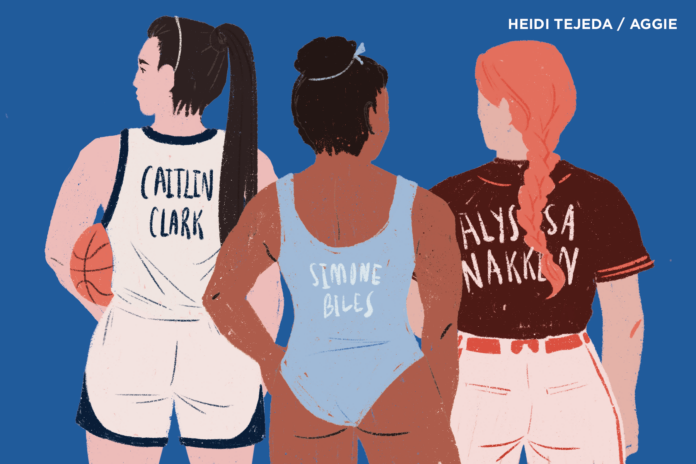Despite historical and social barriers, female athletes deserve adequate pay and attention
By CLAIRE SCHAD — cfschad@ucdavis.edu
Recently, women’s sports have finally been getting the attention they deserve. Whether it’s the unprecedented viewership of the Women’s NCAA basketball championship or the recent success of the Women’s Professional Hockey League, women in sports have been making headlines around the world. Despite the well-deserved news coverage that athletes like Caitlin Clark and Kamilla Cardoso are receiving, there are still steep discrepancies in the way women are treated in the sports world.
At this year’s WNBA draft, Iowa’s Clark was picked first overall by the Indiana Fever, agreeing to a four-year contract with a base salary of $76,535 for her first year in the league. In contrast, last year’s first overall NBA draft pick, Victor Wembanyama, was given a contract by the San Antonio Spurs set to pay him $12.1 million in his rookie season. Even the lowest paid player in the NBA still makes over $1 million each year, only further demonstrating the discrepancies.
The glaring difference in compensation for top male and female athletes has left many people criticizing the WNBA for not properly compensating their players. This criticism led the WNBA to clarify that with media partnerships and other league earnings, Clark stands to make about a half a million dollars during her rookie season, before considering outside partnerships. Even with Clark’s other WNBA earnings, it’s impossible to not see the extreme difference in compensation compared to those in the NBA.
However, it’s not Clark we should be worrying about — as she already signed a contract with Nike featuring a signature shoe that will pay her $28 million over eight years. But rather, it’s the other lesser-known women who have worked just as hard to play professional sports but will never be offered multi-million-dollar partnerships due to a lack of media coverage.
The salaries of female athletes are low due to a number of factors, but at the top of the list is media viewership. Overall, women’s sports bring in far fewer viewers than men’s sports, resulting in much lower revenue. Each year, the WNBA brings in just $60 million in revenue, while the NBA brings in $10 billion. While this steep difference likely results in the much lower salaries of female athletes, it is also important to take a closer look at why the revenues themselves differ so much. Is it solely because the public doesn’t watch women’s sports at the rate they do men’s, or is it something bigger?
The lack of viewership for women’s sports ultimately stems from our society that has, over the course of history, placed more value on the athletics of men than those of women. It wasn’t until relatively recently that women have had the platform to play many sports at the professional level at all. The NBA was founded in 1946, but it wasn’t until 1996 that the WNBA was established. Similarly, while a professional league was established earlier this year, women’s hockey has been struggling to maintain a league for years while the NHL has been thriving for over a century.
Even more frustrating is the fact that many sports still don’t have professional women’s leagues available for athletes, causing many to walk away from their sport after college. While it is encouraging that women’s athletics have been gaining popularity and media coverage in recent years, it is important to look at the societal and historical structures they face.
Despite the constant discrepancies, it’s clear that women’s sports can bring in viewership when they are given the platform to do so. The 2024 women’s NCAA basketball tournament brought in an astounding 24 million viewers this spring, more than the men’s tournament. Last year, the women’s World Cup brought in a record-breaking 1.12 billion viewers.
Encouragingly, viewership for women’s sports is trending upwards, gaining millions of viewers each year. As I’ve gotten older, I’ve been able to witness the joy of female athletes gaining the attention they deserve. Whether it’s Clark in the NCAA tournament, Simone Biles in the Olympics or Megan Rapinoe in the World Cup, seeing these women front and center has brought me and millions of others immense joy.
To ensure this trend continues and that little girls around the world see athletes like themselves represented in sports, media and broadcasting, as well as brands, need to step up their commitment to women’s sports. Without investment from large brands and media corporations, women’s sports will continue to struggle to gain the revenue needed to pay their athletes adequately.
On a final note, I encourage you to seek out women’s sports, whether that is on TV, going to see a local professional team or checking out some of our spectacular female Aggie athletes at one of their next home appearances. After all, the female athletes are out there, but they need our support.
Written by: Claire Schad — cfschad@ucdavis.edu
Disclaimer: The views and opinions expressed by individual columnists belong to the columnists alone and do not necessarily indicate the views and opinions held by The California Aggie.




